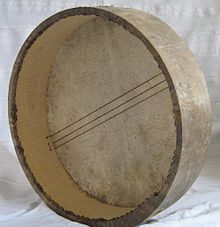Bendir
Bendir ( Arabic بندير, DMG bandīr , Pl. Banadir, bnader ) is a frame drum widespread in North Africa , especially in the Maghreb , which is similar to a European tambourine . The instrument consists of a circular wooden frame covered on one side with goat or sheep skin. Most of the bendir in the Maghreb are changed in sound by snares made of gut on the underside.
The frame, which is bent from a wooden lamella in simple instruments, has a diameter of 20 to 60 centimeters; the same shape is also used for sieves. In contrast to the Arabic frame drums riq and tar, there is no ring collar . The bendir is played while sitting or standing vertically or leaning slightly forward. A thumb is put through a hole in the frame, the other fingers of this hand can be used to hit the drum on the edge or to steam the skin. The fingers of the other hand produce high notes at the edge and lower, dull sounding ones in the middle.
In addition to the darbuka goblet drum and the guellal clay cylinder drum , the bendir provides the rhythm in the popular Algerian music style Raï . The instrument is used in Arab urban music as well as in Berber wedding celebrations in the High Atlas . It is played by men in public music groups, and also by women to accompany singing and dancing at family celebrations, here often together with the oboe instrument ghaita , the wooden flute gasba and metal rattles ( qarqaba ). Singers repeat short melodic phrases as they play a simple rhythm in unison with frame drums and rattles.
Bendix or small clay drums ( tarija ) accompany the Maghreb religious chants and rituals ( Hadhra ) of some Sufi -Bruderschaften ( Sufi brotherhoods ). Where North African frame drums are used south of the Sahara , they remain part of Islamic musical culture. The local use of snare strings on other drums probably also originated in the north.
literature
- Viviane Lièvre: The Dances of the Maghreb. Morocco - Algeria - Tunisia. (Translated by Renate Behrens. French original edition: Éditions Karthala, Paris 1987) Otto Lembeck, Frankfurt am Main 2008, pp. 84f, ISBN 978-3-87476-563-3
Individual evidence
- ↑ Lois Ann Anderson: The Interrelation of African an Arab Musics: Some Preliminary Remarks. In: Klaus P. Wachsmann (Ed.): Essays on Music and History in Africa. Northwestern University Press, Evanstone 1971, p. 163
- ^ Roger Blench: The Morphology and Distribution of Sub-Saharan Musical Instruments of North-African, Middle Eastern, and Asian, Origin. (PDF; 463 kB) In: Laurence Picken (Ed.): Musica Asiatica. Vol. 4 Cambridge University Press, Cambridge 1984, p. 166, ISBN 978-0521278379
